Flax in the Bible weaves a fascinating tale of spirituality and practicality, uncovering hidden layers in ancient texts.
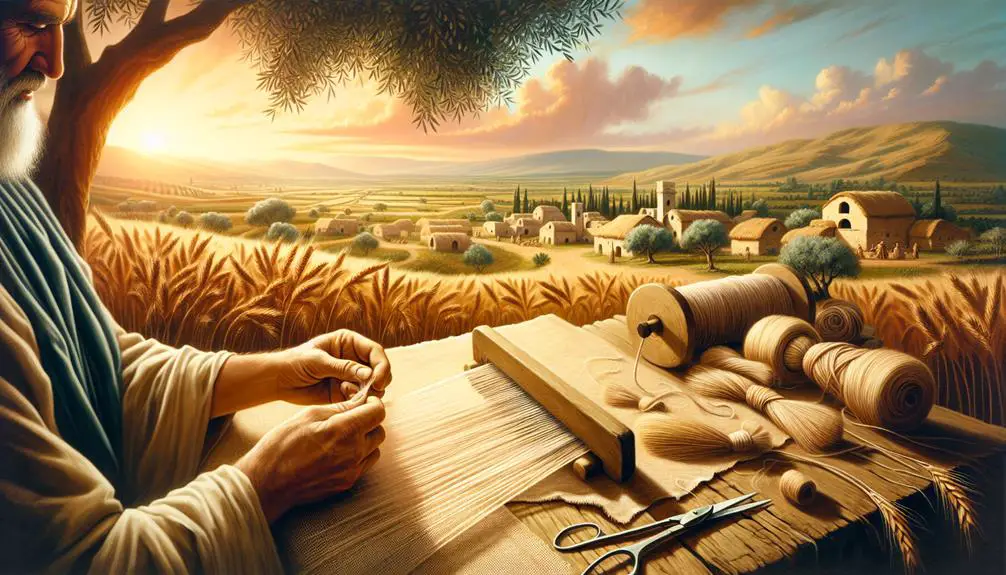
Flax in the Bible
In the tapestry of biblical narratives, flax represents a thread interwoven with spiritual and practical significance, hinting at a deeper story. You might find yourself intrigued by how this humble plant shaped the lives, economies, and even the prophecies within these ancient texts.
Flax's journey from seed to woven cloth in the Bible mirrors the transformation and purity often sought in spiritual quests. As you explore its historical and symbolic roles, consider how something so seemingly insignificant could hold keys to understanding broader themes within these sacred writings.
This might just change the way you view the everyday elements hidden in plain sight in these ancient stories.
Key Takeaways
- Flax symbolized purity and was used in making linen for sacred priestly garments in biblical texts.
- Biblical narratives incorporate flax to highlight its role in agriculture, trade, and spiritual symbolism.
- Prophets like Hosea used flax as a metaphor for judgment and redemption, illustrating deeper spiritual themes.
- The cultivation and processing of flax underscored community connection and sustainability, reflecting societal and spiritual values.
Historical Significance of Flax
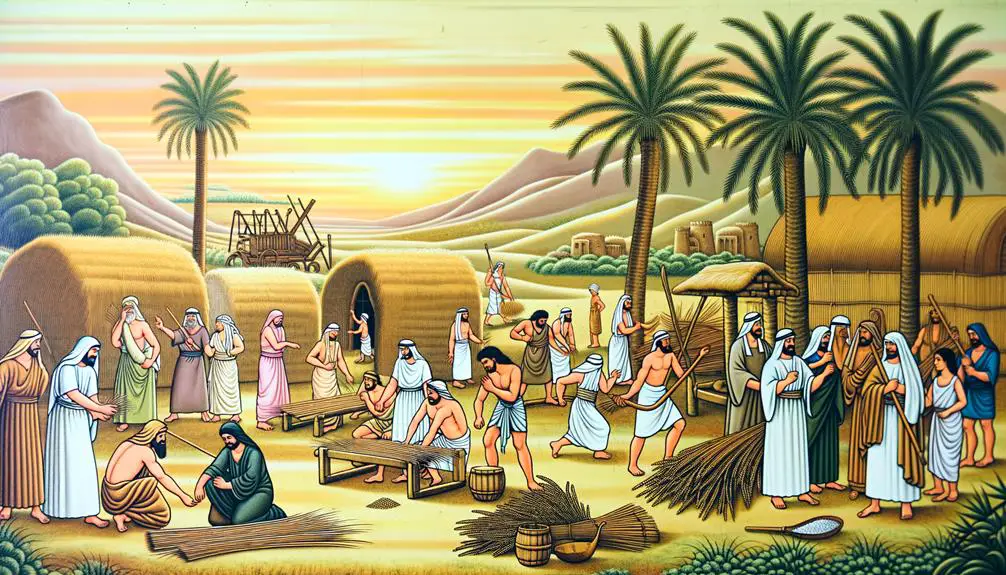
Flax's cultivation and use in ancient societies, particularly as depicted in biblical texts, underscores its critical role in the socio-economic and cultural fabrics of early civilizations. You'll find that the significance of flax cultivation can't be overstated, as it wasn't only a cornerstone of agricultural practice but also a pivotal element in the development of early trade networks. The versatility of flax, capable of being transformed into linen, oil, and other by-products, made it an invaluable resource across various domains of ancient life.
Analyzing the flax trade, one observes its instrumental role in connecting disparate regions and cultures. The exchange of flax and flax-based goods fostered not only economic ties but also facilitated the cross-pollination of ideas, technologies, and cultural practices. This interconnectivity, driven by the demand for flax products, propelled advancements in trade infrastructure, including roads, shipping routes, and marketplaces, further integrating distant societies into a cohesive economic system.
Moreover, the cultivation of flax required a nuanced understanding of agronomy, including crop rotation, soil fertility, and irrigation techniques, reflecting an early sophistication in agricultural science. This knowledge wasn't siloed but shared, contributing to agricultural innovation across regions involved in flax cultivation and trade.
In essence, the historical significance of flax cultivation and its trade extends beyond mere economic metrics; it was a catalyst for societal advancement, technological progress, and cultural exchange. Its legacy is a testament to the ingenuity of early civilizations and their ability to harness the natural world for the betterment of human society.
Flax in Biblical Narratives
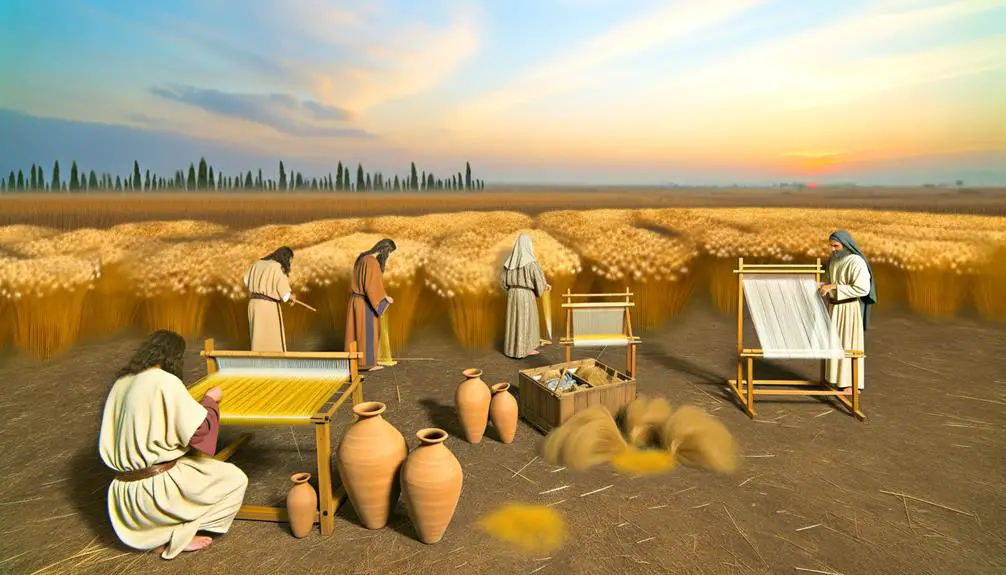
Building on its historical significance, flax also emerges prominently in biblical narratives, where its uses and symbolism offer deep insights into the everyday lives and spiritual practices of ancient peoples. Flax cultivation, as you'll find, isn't merely a backdrop in these stories but an integral part of the socio-economic fabric of the times. Biblical references to flax underscore its utility in making linen, which was highly valued for its purity and used in priestly garments and the tabernacle's inner linings.
Delving deeper, you'll observe that flax cultivation is mentioned explicitly in the book of Exodus, illustrating its importance in ancient Egyptian society, a fact that the Israelites, living within or near this civilization, would have been acutely aware of. This context enriches the narrative, providing a tangible connection to the material culture of the period.
Moreover, the story of Rahab in the book of Joshua offers a compelling glimpse into the use of flax. Here, flax stalks laid out on a roof not only highlight the practical aspects of flax processing—requiring exposure to the sun to dry—but also intertwine with the narrative's tension, as Rahab uses the stalks to hide the Israelite spies. This story illustrates how flax, beyond its economic value, becomes part of the narrative fabric, woven into the events that shape the biblical saga.
In examining these biblical references to flax, you're not just encountering an agricultural product but a window into the lives, trades, and spiritual symbolism of ancient communities. Through this lens, the biblical narratives acquire a richer, more textured understanding that connects material culture with spiritual significance.
Symbolic Meanings of Flax
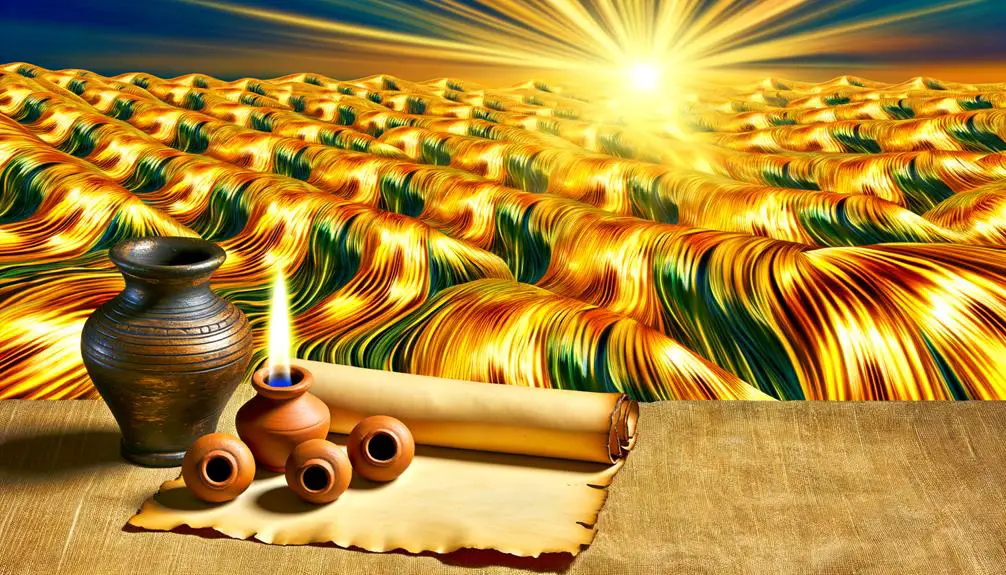
Throughout history, people have imbued flax with a wealth of symbolic meanings, reflecting its significance not only in everyday life but also in the spiritual realm. This plant, integral to the ancient world through flax cultivation and the creation of flax products, carries deep metaphorical significance, which can be unraveled through an analytical lens.
- *Purity and Cleansing*: In many cultures, flax has been symbolically linked to purity. This association might stem from the clean, bright appearance of linen, a flax product, which often symbolizes light and renewal. The process of transforming flax into linen is labor-intensive and transformative, mirroring spiritual purification processes.
- *Sustainability and Prosperity*: The cultivation of flax, a practice that dates back thousands of years, symbolizes a deep connection with the earth and a commitment to sustainable living. Flax's ability to grow in various conditions and its multiple uses, from linen to linseed oil, underscore its role in symbolizing prosperity and abundance.
- *Connection and Community*: The cultivation and processing of flax often require communal effort, symbolizing the importance of teamwork, unity, and the bonds formed through shared endeavors. This aspect highlights how flax products, essential to daily life and commerce, foster a sense of connection among people.
Analyzing these symbolic meanings offers insights into how flax has transcended its material value, embodying spiritual and ethical dimensions that resonate across different cultures and epochs. The symbolic richness of flax underscores its role in human history, not just as a crop but as a catalyst for deeper societal and spiritual connections.
Flax and Ancient Textiles
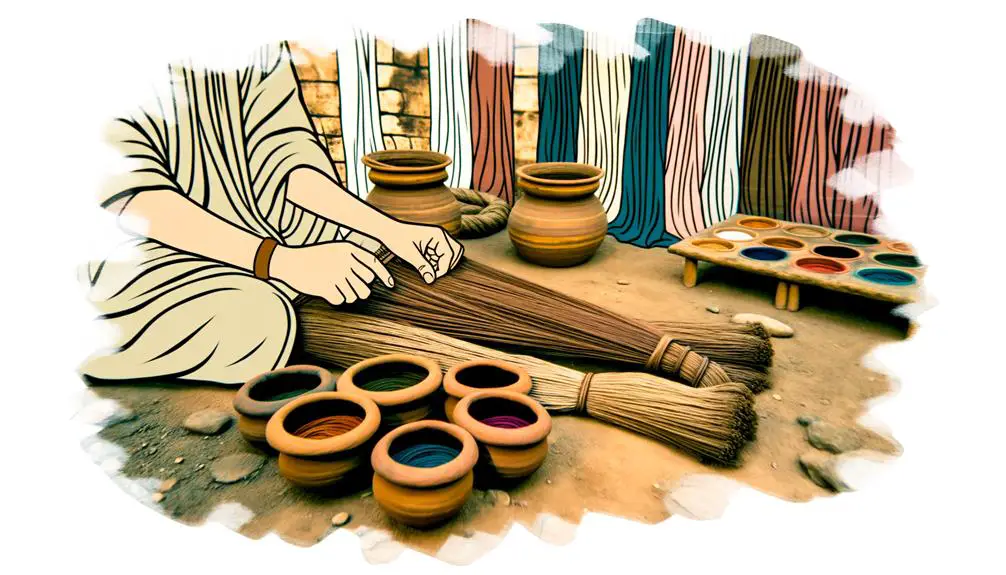
Analyzing the role of flax in the creation of ancient textiles reveals its pivotal influence on early civilizations' economic and cultural fabrics. You'll find that flax cultivation techniques weren't merely agricultural practices but were intertwined with the societal and religious realms, showcasing a profound understanding of the natural world and its resources. The process of transforming flax into linen required skill and knowledge, from sowing and harvesting to retting, scutching, and spinning. This complex procedure underscores the value placed on flax textiles, which were prized for their durability, purity, and beauty.
As you delve deeper into the intricacies of flax's journey from seed to fabric, it's clear that ancient communities weren't only adept at optimizing their natural resources but also at innovating. These early innovations laid the groundwork for what you see in modern flax innovations, where technology has enhanced but not supplanted the fundamental principles of flax cultivation and textile production.
The economic implications of flax production were significant. It fostered trade, as linen was a sought-after commodity in both local and distant markets. Culturally, flax textiles played a role in religious ceremonies and societal rituals, symbolizing purity and connecting the material with the spiritual.
Understanding flax's role in ancient textiles offers a window into the past, where you can appreciate the sophistication of early civilizations and their contributions to the fabric of modern society. The threads of history, woven from flax, illustrate a continuity of human ingenuity and the timeless value of this versatile plant.
Flax's Role in Prophecies

Delving into biblical narratives, it's evident that flax played a crucial role in prophecies, serving not only as a material resource but also as a symbolic element intertwined with divine messages. The cultivation and processing of flax, alongside its by-products, transcend mere agricultural significance, embedding themselves within the rich tapestry of prophetic imagery found in Scripture. This connection offers a deeper understanding of the spiritual and material duality present in biblical texts.
To paint a clearer picture of flax's role in prophecies, consider the following:
- Symbol of Purity and Cleansing: Flax's white blossoms and the process of turning the plant into linen often symbolize purity and transformation, themes central to prophetic visions of restoration and renewal.
- Material for Priestly Garments: The use of linen, made from flax, in crafting the High Priest's attire, as stipulated in Exodus, underscores its significance in ritual purity and, by extension, in prophetic declarations related to holiness and divine service.
- Metaphor for Judgment and Redemption: Prophets like Hosea use the imagery of flax to illustrate Israel's unfaithfulness and the subsequent judgment, yet also hint at redemption. This dual imagery enriches the prophetic narrative, offering layers of meaning to the original audience and later readers alike.
Through these examples, you're encouraged to see flax cultivation not just as an agricultural activity but as a vehicle for conveying profound spiritual truths. The prophetic imagery woven with flax highlights its enduring relevance in biblical scholarship, inviting a contemplative reflection on the material and metaphorical threads that bind the sacred text.
Frequently Asked Questions
How Did the Cultivation and Processing of Flax in Biblical Times Compare to Modern Methods?
When comparing ancient and modern flax cultivation and processing, you'll notice significant differences. Historically, flax varieties were limited, and harvesting techniques were manual, relying on simple tools. Today, you've got a wide range of genetically improved flax varieties and mechanized harvesting, drastically increasing efficiency.
Ancient methods involved labor-intensive retting and scutching to separate fibers, whereas modern processes use advanced machinery, streamlining production and enhancing fiber quality. This evolution reflects technological and agricultural advancements.
Are There Specific Health Benefits Associated With Consuming Flax or Its Products Mentioned in Biblical or Historical Texts?
You're diving into the world of flax recipes, seeking the ancient roots of its health benefits. Like unearthing a treasure, nutritional analysis reveals flax's rich omega-3 fatty acids, fibers, and lignans.
Historically, though explicit mentions in texts are scarce, the implied use of flax in diets suggests a recognition of its value. Analyzing these ancient practices offers a scholarly glimpse into the enduring wisdom of incorporating flax into one's diet for its nutritional wealth.
Can Flax Be Found in Regions Outside Those Described in the Bible, and How Did It Spread Globally?
Absolutely, flax thrives in areas beyond those depicted in ancient texts, thanks to trade routes and a rich genetic diversity.
As traders moved goods across continents, they inadvertently spread flax seeds, weaving a global tapestry of cultivation.
This genetic diversity within flax populations enabled it to adapt to various climates and soil types, ensuring its survival and proliferation far from its origins.
Thus, flax's journey is a testament to human commerce and agricultural adaptation.
Apart From Textiles, Were There Other Less Known Uses of Flax in Biblical Times?
You're diving into a world where flax isn't just a textile but a symbol of purity and truth. Beyond its well-known uses, flax played a role in crafts, embodying a deeper significance.
Analyzing its applications, you'll find flax wasn't merely for clothing but also for items symbolizing a connection to the divine. This exploration isn't just about uncovering flax's versatility but understanding its profound symbolism in shaping cultural practices.
How Do Contemporary Religious Practices Incorporate Flax, if at All, and Has Its Symbolic Significance Evolved Over Time?
You're exploring how flax's symbolic significance and its incorporation into contemporary religious rituals have evolved.
Initially, flax symbolism was deeply rooted in ancient practices. Today, its role in religious rituals might be less pronounced, but it's still present in some cultures, symbolizing purity and connection to tradition.
The evolution reflects broader changes in religious practices and interpretations, showing how the meanings of symbols like flax can shift over time while retaining a core significance.
Conclusion
In sum, flax isn't just a plant; it's the unsung hero of biblical lore, threading its way through ancient texts with the grace of a divine weaver. This humble crop cloaks itself in layers of meaning, from everyday utility to profound symbolic resonance.
Its fibers bind not just linen but the very fabric of prophetic visions and historical narratives, proving that in the grand tapestry of human history, flax is nothing short of miraculous. Its legacy, spun from the fields of antiquity, is a testament to the intertwined nature of the material and the spiritual, forever enshrined in the sacred scriptures.



Sign up